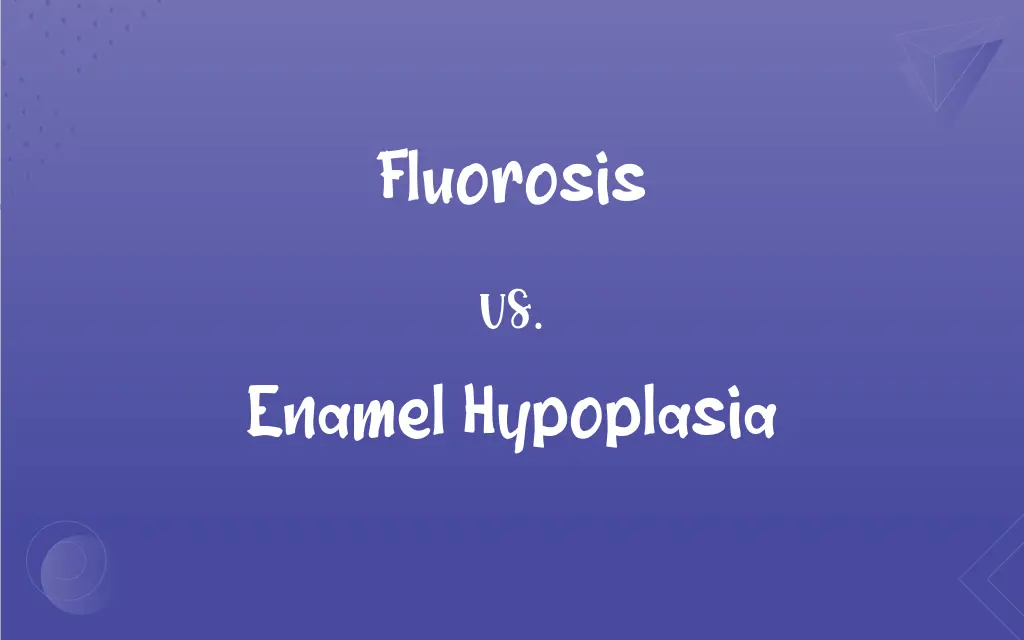Fluorosis vs. Enamel Hypoplasia: What's the Difference?
Edited by Aimie Carlson || By Janet White || Published on February 27, 2024
Fluorosis is a condition caused by excessive fluoride intake leading to tooth enamel discoloration, while enamel hypoplasia is the underdevelopment of tooth enamel due to various factors.

Key Differences
Fluorosis results from high fluoride exposure, affecting teeth's appearance with stains or streaks. Enamel hypoplasia, conversely, involves the incomplete formation of enamel, leading to thin or absent enamel layers.
The primary cause of fluorosis is excessive fluoride during tooth development, often from water or dental products. Enamel hypoplasia can result from nutritional deficiencies, illness, or genetic factors during enamel formation.
Fluorosis typically presents as white or brown discolorations on teeth, and in severe cases, pitting. Enamel hypoplasia manifests as pits, grooves, or thin enamel, making teeth more susceptible to decay.
Fluorosis mainly affects cosmetic appearance, it does not generally weaken teeth. Enamel hypoplasia, however, can lead to increased tooth sensitivity and higher cavity risk due to weaker enamel.
Preventive measures for fluorosis include monitoring fluoride intake in young children. For enamel hypoplasia, prevention focuses on overall health during tooth development, including adequate nutrition and dental care.
ADVERTISEMENT
Comparison Chart
Cause
Excessive fluoride exposure
Nutritional deficiencies, illness, genetics
Symptoms
White or brown discolorations on teeth
Pits, grooves, or thin enamel
Effect on Tooth Structure
Cosmetic changes, typically no weakening
Weakened enamel, increased decay risk
Age of Onset
During tooth development
During enamel formation in teeth
Prevention
Monitoring fluoride intake
Maintaining health and nutrition during tooth development
ADVERTISEMENT
Fluorosis and Enamel Hypoplasia Definitions
Fluorosis
Fluorosis can affect both the appearance and structure of teeth.
Her fluorosis led to slight irregularities in her tooth enamel.
Enamel Hypoplasia
Enamel hypoplasia can result from malnutrition, illness, or genetic factors.
His enamel hypoplasia was likely due to a childhood illness.
Fluorosis
Fluorosis usually develops before teeth erupt through the gums.
Fluorosis is prevented by controlling fluoride exposure in early childhood.
Enamel Hypoplasia
Treatment for enamel hypoplasia often involves dental restorations.
To treat her enamel hypoplasia, she received several dental crowns.
Fluorosis
Fluorosis is a dental condition caused by excessive fluoride causing tooth discoloration.
The child's fluorosis was evident in the streaks on his teeth.
Enamel Hypoplasia
Enamel hypoplasia can affect both baby and permanent teeth.
Enamel hypoplasia in her baby teeth predicted similar issues with her adult teeth.
Fluorosis
Severe fluorosis can lead to pitting and mottling of teeth.
His severe fluorosis required cosmetic dental treatments.
Enamel Hypoplasia
Enamel hypoplasia is a defect of the teeth characterized by underdeveloped enamel.
The dentist diagnosed her sensitive teeth as enamel hypoplasia.
Fluorosis
Dental fluorosis is often seen in areas with high fluoride in water.
Water fluoridation levels were adjusted to reduce fluorosis risk in the community.
Enamel Hypoplasia
This condition often leads to increased tooth decay and sensitivity.
Her enamel hypoplasia made eating cold foods painful.
Fluorosis
An abnormal condition caused by excessive intake of fluorine, as from fluoridated drinking water, characterized chiefly by mottling of the teeth.
Fluorosis
(medicine) Any adverse condition due to an excess of fluoride.
Fluorosis
A pathological condition resulting for an excessive intake of fluorine (usually from drinking water)
FAQs
Can fluorosis be reversed?
Fluorosis is permanent, but cosmetic treatments can improve appearance.
What health conditions can cause enamel hypoplasia?
Conditions like nutritional deficiencies or certain illnesses during tooth development.
Does enamel hypoplasia affect tooth strength?
Yes, it can lead to weaker teeth and increased decay risk.
What are the symptoms of enamel hypoplasia?
Symptoms include thin or absent enamel, leading to pits or grooves in teeth.
How can fluorosis be prevented?
By monitoring and controlling fluoride intake in young children.
At what age does fluorosis occur?
Fluorosis occurs during tooth development, typically in early childhood.
What causes dental fluorosis?
Dental fluorosis is caused by excessive fluoride intake during tooth development.
Are there different severities of fluorosis?
Yes, fluorosis can range from mild discoloration to severe mottling.
Does fluorosis affect all teeth equally?
Fluorosis usually affects all teeth exposed to fluoride during development.
Is enamel hypoplasia hereditary?
It can be, as genetic factors play a role in its development.
Can enamel hypoplasia be treated?
Yes, treatments may include dental restorations and sealants.
How does enamel hypoplasia impact oral health?
It increases susceptibility to cavities and tooth sensitivity.
Is fluorosis common in the United States?
It's relatively common in areas with naturally high fluoride levels in water.
Can enamel hypoplasia be detected early?
Yes, dentists can often detect it in early stages through dental exams.
Can enamel hypoplasia occur in adults?
It primarily occurs during tooth formation, so it's usually diagnosed in children.
Does bottled water reduce the risk of fluorosis?
Bottled water with low fluoride levels can reduce the risk.
Can fluoride filters prevent fluorosis?
Yes, they can help reduce fluoride levels in drinking water.
What are cosmetic treatments for fluorosis?
Treatments include teeth whitening, veneers, or bonding.
What dietary factors influence enamel hypoplasia?
Adequate intake of vitamins and minerals is important for preventing it.
Are there special toothpastes for enamel hypoplasia?
Toothpastes for sensitive teeth can be beneficial for enamel hypoplasia.
About Author
Written by
Janet WhiteJanet White has been an esteemed writer and blogger for Difference Wiki. Holding a Master's degree in Science and Medical Journalism from the prestigious Boston University, she has consistently demonstrated her expertise and passion for her field. When she's not immersed in her work, Janet relishes her time exercising, delving into a good book, and cherishing moments with friends and family.
Edited by
Aimie CarlsonAimie Carlson, holding a master's degree in English literature, is a fervent English language enthusiast. She lends her writing talents to Difference Wiki, a prominent website that specializes in comparisons, offering readers insightful analyses that both captivate and inform.






































































